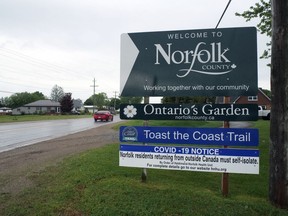
When choosing where to put new housing, municipalities in Ontario are supposed to stay away from farmland, particularly “prime agricultural” land ideal for specialty crops.
Advertisement 2
Article content
In Norfolk County, that is almost impossible.
Article content
“The majority of land in Norfolk is prime ag,” said county planner Nicole Goodbrand during a meeting on Tuesday where councilors debated proposals from developers to expand Norfolk’s urban boundary.
The boundary review process was sparked by a 2021 study from Watson and Associates Economists that predicted Norfolk’s population will swell by nearly 30,000 to reach 92,700 by 2051.
To handle that growth and build 9,600 new homes, planning staff recommends focusing on intensification and developing available land within the existing urban boundaries.
But staff predict the county will also need 294 acres of new residential land and 129 acres of employment land over the next 25 years.
Advertisement 3
Article content
To Mayor Amy Martin, the urban boundary review — Norfolk’s first such exercise in more than two decades — is council’s chance to make big-picture decisions about land use.
“Growth should not be piecemeal, focused solely on housing,” the mayor said.
Expanding Norfolk’s urban boundary is a complicated process because the municipality does not have one such boundary, but five.
On Tuesday, councilors spent hours considering each of Norfolk’s urban areas — Simcoe, Delhi, Waterford, Courtland, Port Dover and Port Rowan.
One by one, developers lined up to extol the virtues of their plans for each community.
The only major proposal that does not involve paving over farmland is a plan by Markham-based developers Geranium to turn the shuttered Delhi Golf Course into an 874-unit subdivision.
Advertisement 4
Article content
The local chamber of commerce says building on the 77-acre site would bring in new residents and businesses.
“We have a developer today who is ready to make this investment in Delhi. Let us not stand in their way,” chamber president Mark Spence told councilors.
But some residents — including Coun. Mike Columbus — opposes the idea, saying Delhi lacks the needed infrastructure and already has room for more than 1,000 new homes within the existing urban boundary.
“It’s just too much, too fast,” Columbus said.
The owner of a 124-acre property in the west end of Simcoe wants council to add their land to the urban boundary and grant a three-year window to negotiate putting a new “health-care campus” on the site to replace Norfolk General Hospital .
Advertisement 5
Article content
The proposed campus — which Martin said would be a “legacy project” for council — could include a new hospital, nursing home, hospice and post-secondary institution connected to Fanshawe College.
Councilors had glowing words for a plan from Mike and Sandy Kloepfer — owners of Titan Trailers in Courtland — to build a 150-acre industrial park across from their business in western Norfolk, with 400 new homes nearby.
There will be no land added to the urban boundaries of Port Rowan and Port Dover, as Port Rowan is expected to see negligible growth by 2051 while Port Dover already has more than 300 acres of available residential land within the current boundary.
An open house last August to gauge residents’ views on Norfolk’s growth options attracted about 50 people, mainly developers. The public gallery inside council chambers was full on Tuesday, with developers and building consultants again outnumbering neighbors of the planned builds.
Advertisement 6
Article content
That led to different characterizations of the prevailing public opinion about development.
The builders behind an 800-home subdivision proposed for Waterford claim residents are clamouring for the services and amenities their development would allegedly attract.
But Waterford-area Coun. Kim Huffman said she has only heard negative feedback from “nervous” residents who complain their small town is already “overwhelmed with development.”
Planning for growth “is very much a balancing act” between current and future needs, Goodbrand told councilors, noting urban sprawl can eat up available farmland while not guaranteeing the types of housing residents need.
Coun. Chris Van Paassen urged his fellow advisors to resist the pressure from developers to “go big.”
Advertisement 7
Article content
“My priority is to do what makes sense,” he said.
But Martin said the provincial push to build 1.5 million new homes by 2031 makes growth in Norfolk “inevitable.” She argued it is incumbent on council to work with developers and secure concessions on how communities are built rather than opposing growth and likely losing expensive appeals at the provincial land tribunal.
“You can say no to growth today, but growth won’t wait … and we’ll be faced with the same decisions in five years,” Martin told advisors.
The debate over how and where Norfolk should expand will continue at another public meeting in May.
Final decisions on amending Norfolk’s official plan and changing the urban boundary are subject to provincial approval.
JP Antonacci is a Local Journalism Initiative Reporter based at the Hamilton Spectator. The initiative is funded by the Government of Canada.
Article content